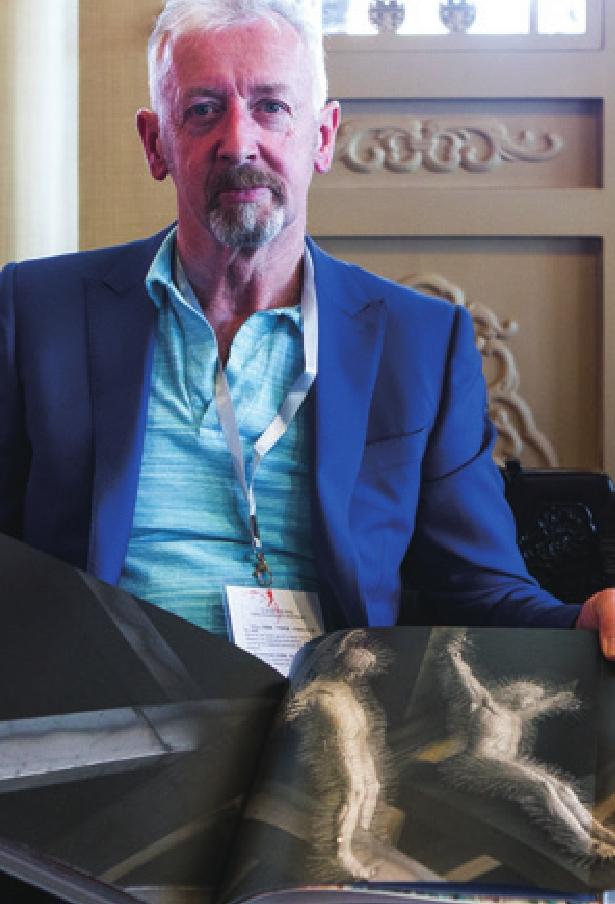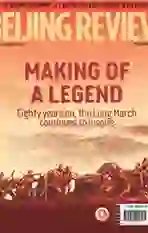Juliet in Forbidden City
2016-05-14BySudeshnaSarkar&YuanYuan
By Sudeshna Sarkar & Yuan Yuan

While Romeo and Juliet were pas- sionately whispering their undying love to each other and readiness to defy parental anger, and even death, the audience was amazed to hear notes from the Kunqu Opera. Then a second beautiful heroine appeared on stage, a scene never imagined by William Shakespeare.
It was Du Liniang, the heroine of Peony Pavilion, the masterpiece of Tang Xianzu, the Chinese playwright who lived in the same age as Shakespeare.
The unusual spectacle at the Palace Museum, formerly the Forbidden City, the Chinese imperial palace for almost 500 years and the heart of the nations art, culture and literature, on September 28 was an effort to show how art transcends borders. Though Tang and the Bard of Avon lived on different continents and in different cultures, their works depict the same human passions of love, longing and despair.
“The celebrated author of Hamlet, Shakespeare, and Ming Dynasty playwright Tang Xianzu lived in the same period,” said Wang Yamin, Executive Deputy Director of Palace Museum. “Although they lived in different societies and had different backgrounds, both created beautiful works which continue to influence society.”
Signs in history
History shows China has always encouraged cultural exchanges. The court of the Emperor Qianlong, the Qing Dynasty (1644-1911) ruler whose reign was one of the longest in China, exemplified Eastern and Western cultural exchanges, Wang said. The emperor was a connoisseur of art who read classics, encouraged translations and had Western artists paint in his palace.
Cultural links between China and the UK are strengthening, creating what British Prime Minister Theresa May has called a“golden era” of Sino-British cooperation and strategic partnership. Several high-level visits have contributed to this synergy.
In March, Prince William visited China, the first British royal to do so in nearly three decades. In October 2015, President Xi Jinping visited the UK and took part in the commemoration of the China-UK Year of Cultural Exchange. In September 2016, Prime Minister May attended the G20 Summit in Hangzhou, China.
According to Martyn Roper, Minister and Deputy Head of Mission at the British Embassy, currently there are 150,000 Chinese students enrolled in various British educational institutions. The number of Chinese tourists to the UK has doubled in the last five years and the British Government is issuing two-year multiple-entry visas to Chinese visitors.
Hong Kong-based Phoenix Satellite TV has taken an initiative to enhance SinoBritish ties. In collaboration with the British Council, it brought together academics, celebrated artists and designers from China and the UK at a China-UK Art and Aesthetics Forum in Beijing last month.
“China and the UK marked their cultural exchange year in 2015, supported by leaders from both sides and enhanced exchanges and dialogue between artists from both sides,” said Huang Xiaoyan, CEO of Phoenix TV Culture Link Development, a unit of Phoenix TV. The unit had organized a China-UK Art & Fashion Gala to present the Chinese fashion industry, vibrant and modern and yet linked to past traditions, before an international audience. “The aim of this event is to explore more possibilities of cooperation in the art and fashion industry and present Chinese aesthetics at an international level,” Huang added.
Wear a masterpiece
The fashion gala is an example that Chinese designers have embraced modernity and yet retained their cultural roots. Phoenix TV Culture Link organized a competition, asking designers to fashion their clothes in a way that would also showcase the works of celebrated Chinese painters including Yang Mingyi, whose ink paintings of Zhouzhuang, a popular water town in Zhejiang Province, have given another dimension to the resort.
Over 20 male models showcased a varied line of mens clothing which incorporated sketches by the artists.
“The Chinese style is not just a simple combination of some Chinese elements such as silk or porcelain patterns, it is more about the whole feeling of the design, which shows the personality of our country,” said Zhou Lichen, General Manager of Heilan Home Garment Co. Ltd., a leading clothing company for men that sponsored the design competition. “What we sell is not just products, but a cultural image and we want to spread it to more places in the world.”
“Chinese elements are not just limited to silk or some specific patterns, there is a lot more that China can offer to the world,”concurred Kobi Prempeh, a British lawyer who left the legal profession to embrace art.
Prempeh remembered his childhood when his sister loved to wear Chinese-style clothes.“Fashion is becoming less Western-focused now and I am happy to see Chinese models are getting more popular in the international circle,” he said. “Chinoiserie is once again gaining popularity in the international fashion world. British fashion designer Alexander McQueen was highly influenced by it.”
Prempeh wants to make a documentary on Chinas fashion and art world. “Art is very beautiful. It has its own language that can overcome the linguistic obstacles of different languages,” he said. “You just need to see it and feel it. It is amazing. Though separated by vast continents and oceans, our conversation has continued, first through tea[which was grown in China first]. I hope the conversation never dies.”
When coat hanger is art
While Western audiences get to see Chinese creations, it is an enlightening experience for Chinese also to see the works of popular Western artists. Scottish artist David Mach, who started as a sculptor and then included collage in his repertoire, is bound to come as an eye-opener to a nation where art has often been synonymous with priceless mediums, like jade and gemstones.
The 60-year-old chooses the most humdrum things conceivable to create massive, and often sublime, artwork. “I love to use items of daily use, such as matches, tires, hooks, pins,” he told Beijing Review.“I like to use things people know in their daily lives, whether they are Chinese or Scottish, things that are ordinary, not gold or silver.”
Mach has been creating portraits and masks with matches since 1982, when they were still a daily necessity. Once, while making an image, he accidentally started a fire. Since then, at times he even does it deliberately during an exhibition. He has also used hundreds of tons of old magazines and even old phone directories to create life-size trains.
Fantastic as it may sound, his work has a strong China element. He calls it a “really weird mixture of cultures going together.”Mach has been using screws and coat hangers, millions of them, all of the pieces made in China, to make his images. The pieces he creates are incredibly lifelike and identifiable straightaway, especially his Biblical art.
The sculpture darkly called Golgotha, the place where Jesus Christ was crucified, shows Christ with two thieves, his last companions in death, all three on the cross. The hooks look just as real ones would have, tearing through the flesh and creating a tableau of utter agony. “It was made of millions of coat hangers made in China,” he said.
“No matter where you live, China will always come into the view. Its a big player,”said Mach, on his second visit to China, the first one having taken place over a decade ago. “For years, you couldnt go into a bookshop without being bombarded by Chinese authors. China has become part of your life even in a little village in Ireland where 10 to 20 articles in any shop will be from China.”
Power of artists
Mark Dunhill, Dean of Academic Programs at Central Saint Martins, a leading art and design college in the UK, said many fashion students in the UK are from China. “We need to collaborate,” he said. “Knowledge exchanges can help overcome challenges for a sustainable future. To generate dialogue and exchanges, artists need to be included in strategic discussions.”
This inclusion is vital because art and design, he emphasized, can change human behavior and make the world a better place. With social media being a strong power today, it would change the way fash- ion and art work.
“Fashion design conveys information that is more than clothes,” Dunhill said. “It tells stories of the culture it represents and it is very profound. When you wear clothes, you wear a way of life. It is the same with artwork as artists put their understanding of beauty and life in their works.”
Besides creating a stronger bond with the Western world, art and culture is creating greater understanding and harmony at home and in the region.
Victoria Lu, one of the first women curators of modern art in China, was born in Taiwan, lived in the United States, and now has returned to Taiwan. A professor in the Graduate Institute of Creative Industries of Shih Chien University, Lu, who has curated many art exhibitions around the world, is now working on a project involving square dancing. It is the Chinese social phenomenon that sees people, often senior citizens, gathering in public places in the evenings to dance together. It is a way of socializing as well as staying fit.
Lus project is in Guizhou Province in southwest China. She has created a dance troupe with local people who love dancing and plans to organize a dance tour. “It is not typical square dancing,” She said. “We have included many local styles and I think we can dance all over the world.”
